With Our German Pretzel Recipe You Can Make Authentic Pretzels Every Time!
Searching for a trusted German pretzel recipe? Our German soft pretzel recipe (without lye) creates authentic German pretzels – commonly known as Laugenbrezeln – just like you’d get in Germany!
These twisted baked goods are a German classic. They can be found in any German bakery – sometimes cut in half with butter or even with cheese melted on top!
German pretzels are often eaten with Weißwürste or with Obatzda, the delicious Bavarian cheese spread.
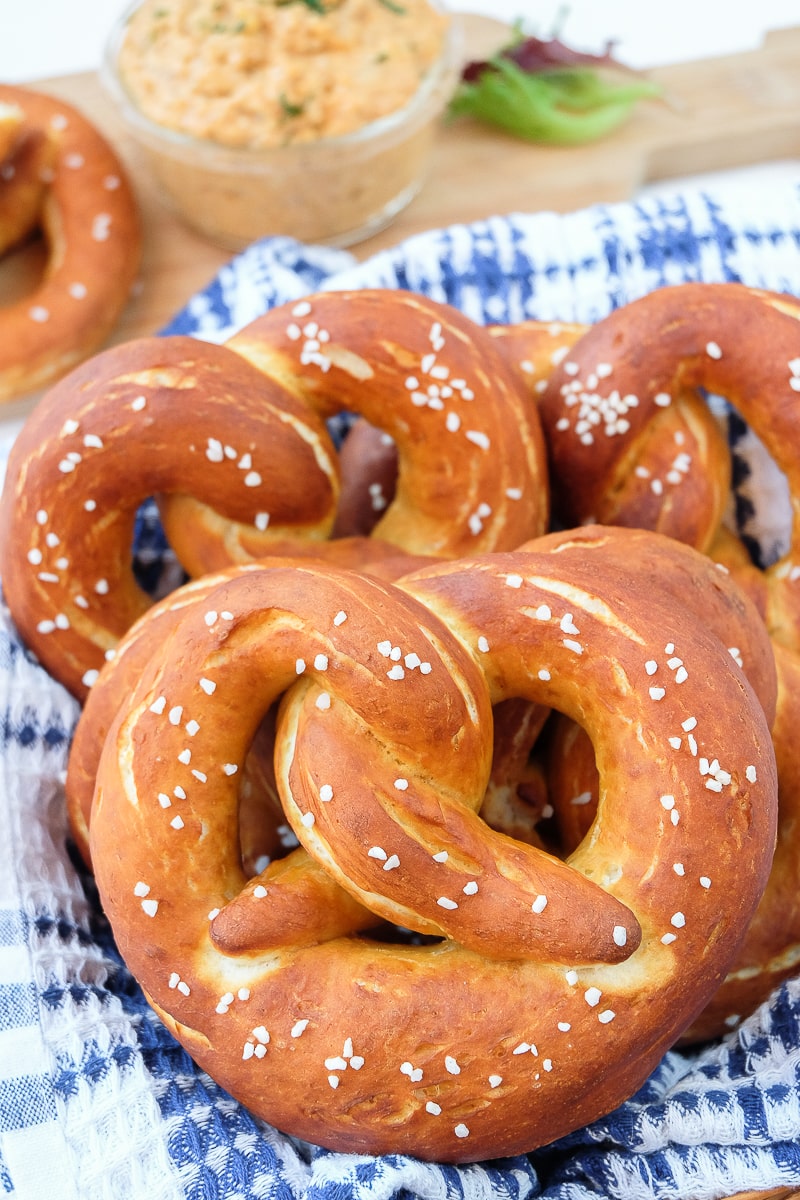
As we mentioned, these pretzels are called Laugenbrezeln in Germany, sometimes also just Brezn, or even some other regional names.
There are different types of pretzels in Germany, but the Laugenbrezel is by far the most common one.
You can find the same dough that these pretzels are made from also in the shape of a small “baguette” – then they are called Laugenstangen.
Lisa grew up in Germany – she’s actually from Bavaria – so she used to eat pretzels all the time. They are very popular – especially when Oktoberfest rolls around!
When Eric came along, pretzels became something we’d grab when on-the-run travelling from city to city by bus or train.
Lisa likes her pretzels warm out of the oven with a little bit of butter while Eric likes them with as much coarse salt as possible!
Making German Pretzels Without Lye
The secret to German pretzels is to make them with lye – it’s how they get their color when baked.
Lye is a basic (on the pH scale) and dangerous chemical compound. That’s why we – and many other non-professional bakers – don’t like use lye in our kitchen.
We use baking soda and it gives the pretzels the same outer color. So, we’re confident with our German pretzel recipe without lye since it still creates the perfect pretzels with a soft center and golden brown outside.
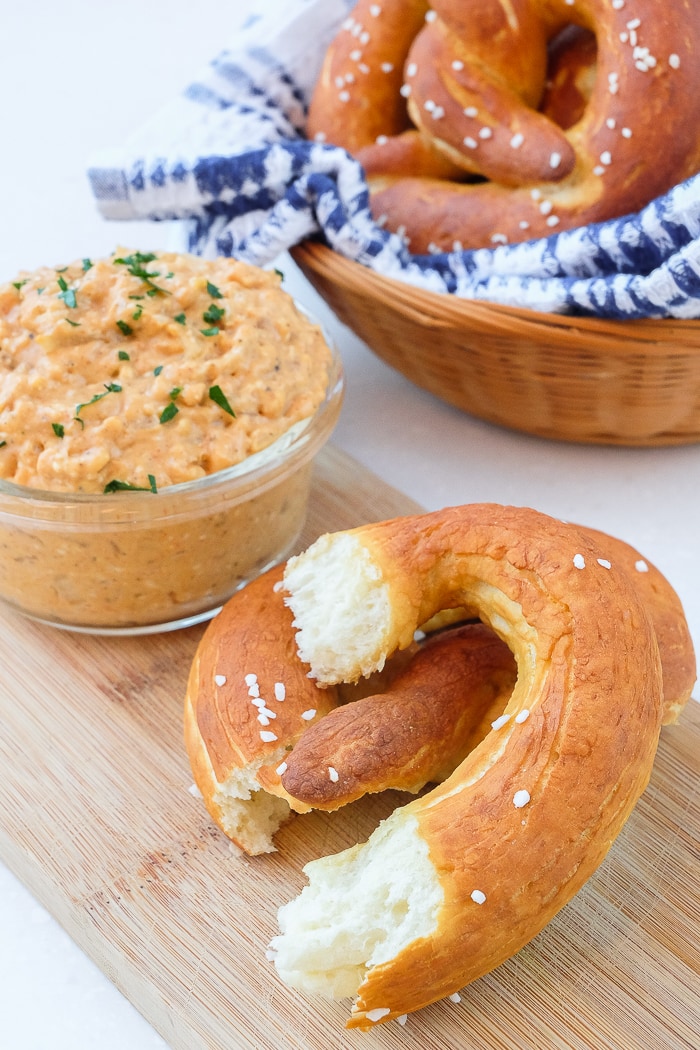
German Pretzels vs North American Pretzels
If you are from North America, you might mainly know pretzels out of a bag as a small crispy snack.
While these snacks are also available in Germany, traditional German pretzels are a lot softer and larger.
Kind of like the ones you’d find at a North American amusement park or county fair. These are generally called “soft pretzels” – which are the closest equivalent to an authentic German Laugenbrezeln.
Sometimes in North America, you can buy a soft pretzel with a cheese dip (usually at a sports game) but this “dip” isn’t popular in Germany. The closest would be Obatzda or melted cheese on the Brezn!
How to Make German Pretzels – Step by Step Instructions
If you want to make authentic German pretzels, you can follow the German pretzel recipe card at the bottom of this post – and have a look at the pretzel web story for a recipe summary.
Since German soft pretzels can be difficult to get a hang of the first time, we’ve included the detailed pretzel recipe photos below.
This way, you can follow the recipe steps and see how each one should look – especially the proper way to fold the pretzels!
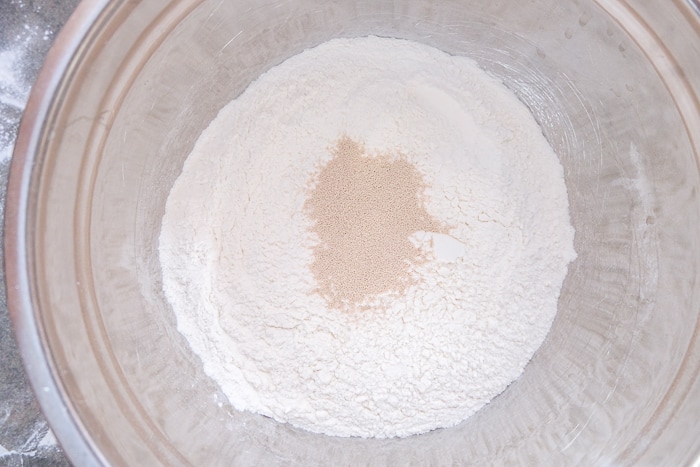
First, place the flour, salt, and sugar into a large mixing bowl. Give everything a good stir with a spoon.
Then sprinkle the instant yeast on top and give everything another stir.
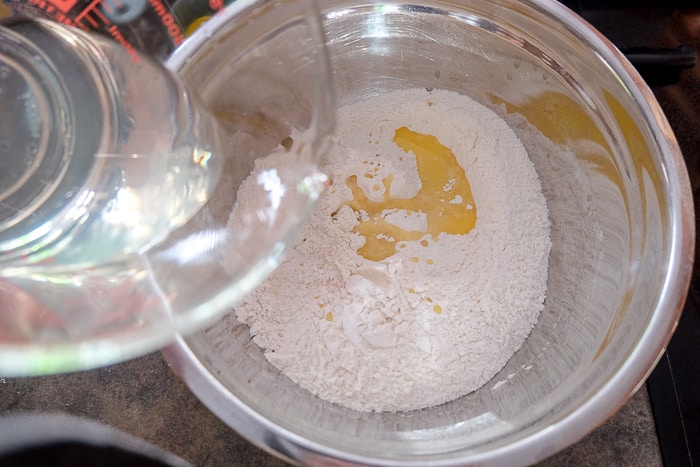
Add the melted butter and then slowly pour the warm water and warm milk into the bowl while kneading the dough with the spiral dough hooks of your electric mixer.
Alternatively you can also mix the dough with your hands – just know that it will probably take a little bit longer.
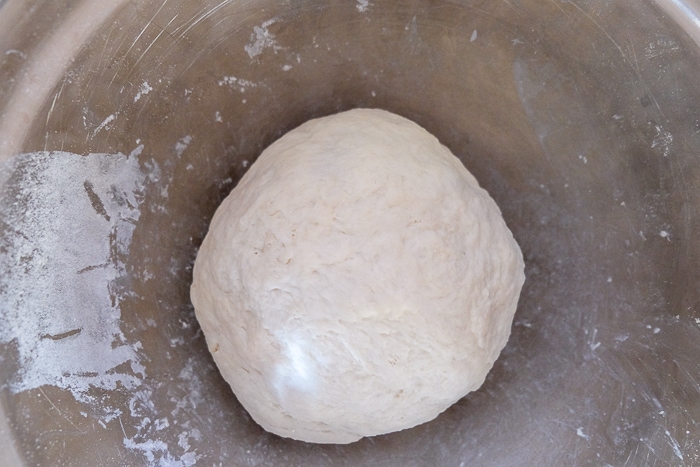
Keep kneading the dough until it has an elastic feeling and forms a ball that doesn’t stick to the side of the bowl anymore.
If the dough is too dry, add a tiny bit more water and knead it again. Make sure to not add too much water at once since just a little bit of water can make a huge difference already.
On the other hand, if the dough feels to sticky, add a little bit more flour and knead again.
Form a nice ball with your hands, then cover the bowl with the dough inside with a dishtowel or lid. Place it in a warm spot without draft for one our to allow the dough to rise.
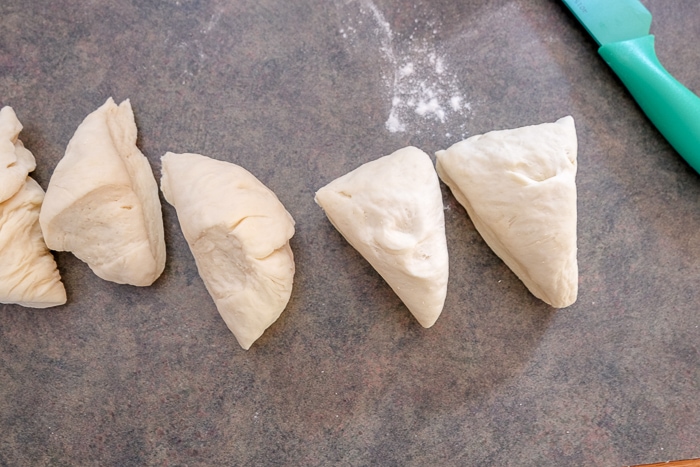
Once the dough has noticeably increased in size, sprinkle a little bit of flour onto your countertop.
Briefly knead the dough using your hands, then cut it into eight equally sized pieces.
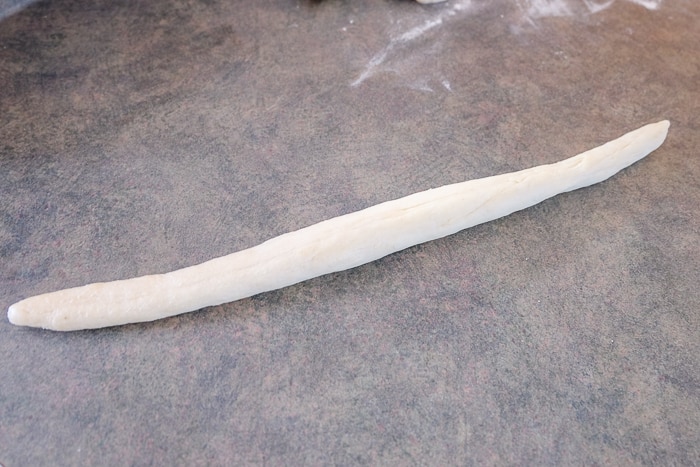
Roll these small pieces into approx. 26-inch long rolls. Make sure that the two ends are noticeably thinner than the middle to give the pretzels their distinct shape.
If you’re having trouble rolling your dough or it shrinks back together, wet your hands with a little bit of water and try again.
It’s important that you make the “dough sausage” long enough so you can make a good sized pretzel that still has some noticeable holes in it after baking.
One of the biggest mistakes we see people make is making the “dough sausage” too thick and thus their pretzel too small.
Since they expand slightly in the oven if they are too small and/or too thick before baking you risk losing that distinct pretzel look.
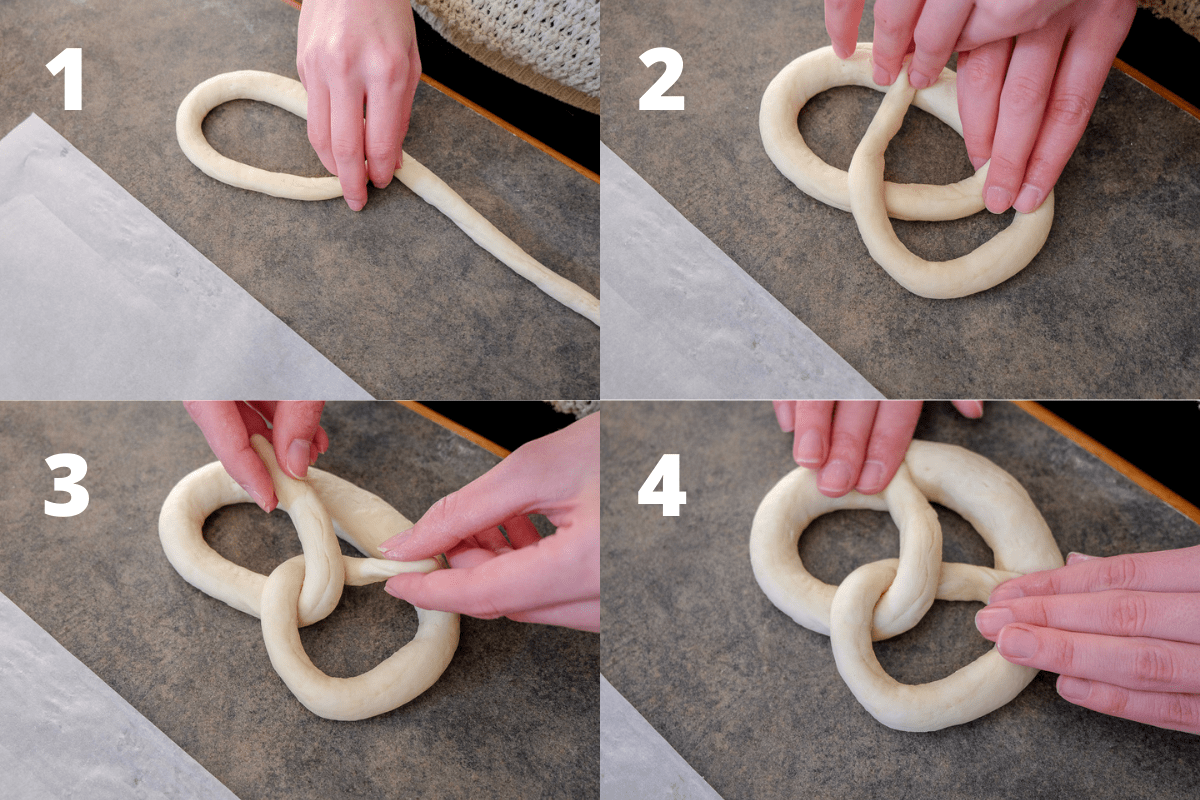
Once the “sausage” is long enough, it’s time to give it that unique pretzel shape.
- Fold in one end of the roll towards the middle.
- Fold in the other end of the roll towars the middle crossing over top of the other end.
- Take both ends and twist them.
- Press down the ends to the side of the pretzel. You can use a bit of water to make it stick better.
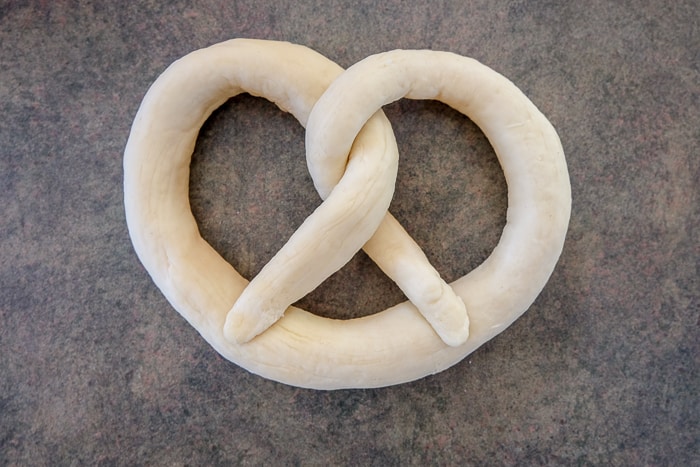
It might take a couple of tries to get a hang of it, but shaping pretzels is honestly not that difficult!
When you are happy with their shape, place the formed pretzels onto a baking sheet with parchment paper.
We can usually fit four pretzels onto on baking sheet. So, when we make this recipe we usually have two baking sheets that we put into the oven one after the other.
Once you have placed the pretzels onto the parchment paper, let them rest for another 15 minutes.
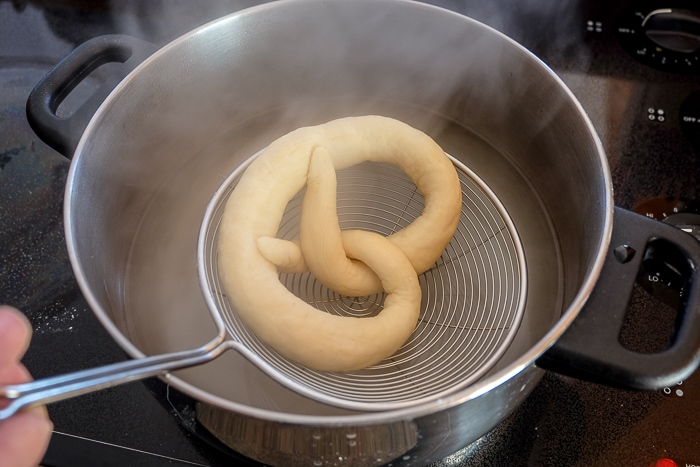
In the meantime, preheat your oven to 390 degrees Fahrenheit. Also, bring approx. 4 cups of water to a boil in a pot that will fit one pretzel at a time.
Once boiling, add the baking soda and give the mixture a stir. Remove the pot from the heat.
With a flipper or straining spoon, lower one pretzel at a time into the baking soda mixture and allow it to sit in there for 30 seconds.
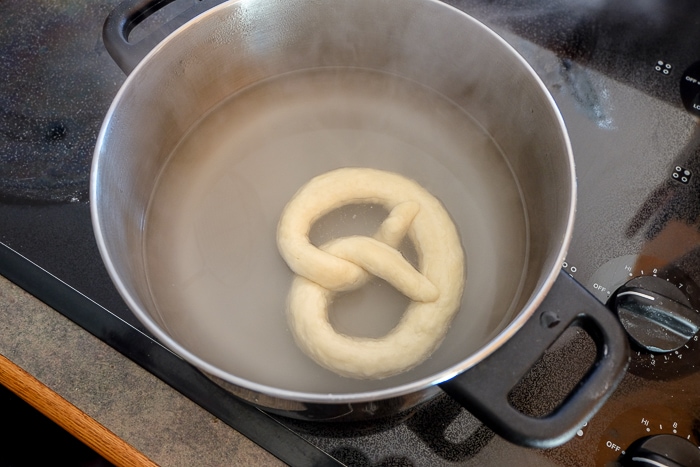
Make sure that the whole pretzel is covered. If it isn’t, you can flip it after 15 seconds or “baste” the top of the pretzel.
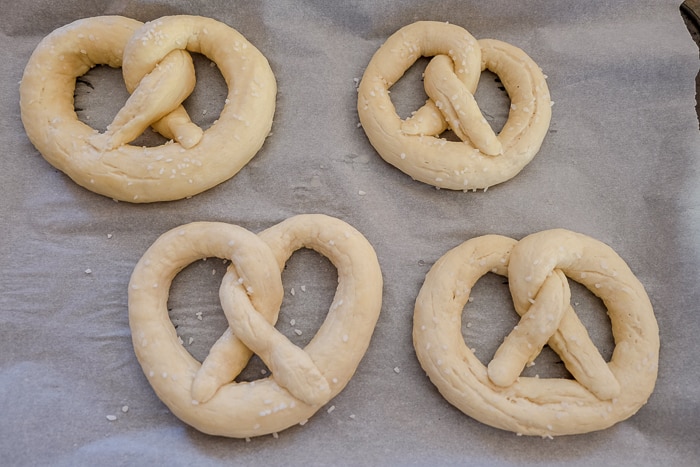
When done, remove the pretzel from the water and allow excess water to drip of.
Then place it back onto the parchment paper and sprinkle it with coarse salt (if desired – the amount is completely up to you).
Repeat this step until all pretzels had their bath and are sprinkled with salt.
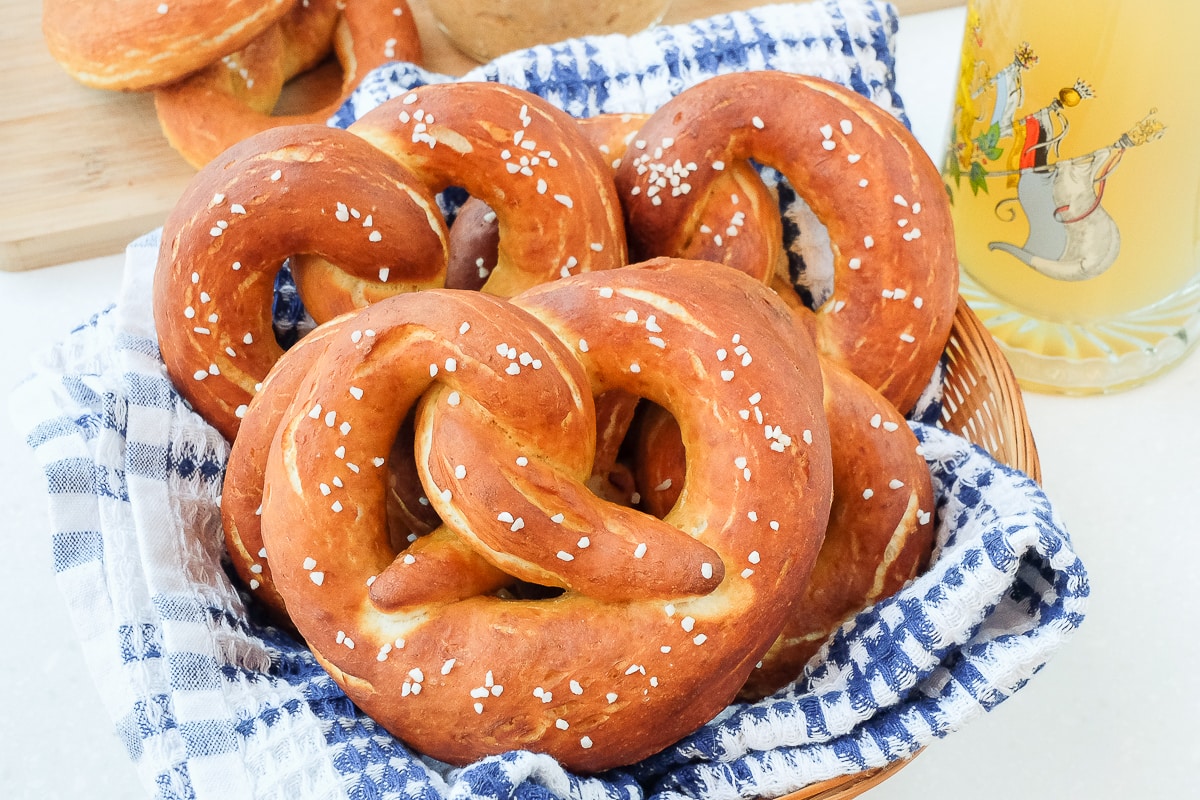
Bake the pretzels in the middle rack of your oven for approx. 20 minutes until they are nicely brown in color.
If you have two (or more) baking sheets, then we would recommend baking them in two (or more) rounds.
Remove the Laugenbrezeln from the oven and let them sit for around 5-10 minutes. You can enjoy them warm or cold.
Storage Tips
German pretzels definitely taste best when fresh. However, you can store leftover pretzels in a container with a lid or in a sealed plastic bag for 1-2 days.
Before consuming, you can put the pretzels in the oven for a few minutes to make them slightly crispy again. You can also cut them in half and toast them.
Alternatively, you can also freeze leftover pretzels. Just make sure to remove as much air as possible and to use a freezer friendly container or bag that seals well.
Place the frozen pretzel in the oven until crispy.
German Pretzels FAQ
In Germany, pretzels are commonly called Laugenbrezeln or just Brezn, for short. There are other regional names for pretzels in Germany.
In Germany, there is really no difference between a Bavarian pretzel and a “regular” pretzel. Both are soft pretzels made in bakeries and eaten all over the country.
Pretzels were typically more popular in Bavaria but nowadays they can be found in bakeries and supermarkets all over the countries. People from other countries may also associate pretzels more with the southern state of Bavaria because of Oktoberfest celebrations.
Of course, there is a big difference between an authentic German pretzel and the small, crispy, baked snack pretzel eaten in North America.
There is no specific ingredient that makes a soft pretzel taste like a “pretzel”. However, the signature taste of pretzel (compared to another similar baked good from a similar dough) is from the brown outer coating on the dough.
This is achieved by dipping the raw pretzel dough in lye – but it can also be achieved by using a water and baking soda mixture on the stovetop.
It isn’t that difficult to make German pretzels from scratch. All you do is make the dough and let it rise, roll it and form the pretzel shape, bath them in the baking soda solution, salt them, and finally bake them.
You can follow the detailed recipe card below to make delicious German Pretzels at home.

German Pretzels (Laugenbrezeln)
Ingredients
The Dough
- 4 cups all-purpose flour
- 1 1/2 teaspoons salt
- 1/2 teaspoon sugar
- 2 1/2 teaspoons instant dry yeast
- 2 tablespoons butter, melted
- 1 cup water, warm (possibly a tablespoon more)
- 1/2 cup milk, warm
“The Bath”
- 4 cups water
- 3 tablespoons baking soda
The Topping
- coarse salt
Instructions
- Add the flour to a large mixing bowl. Add the salt and sugar and give everything a good stir.
- Sprinkle the instant yeast on top, then give it another stir.
- Add the butter. Then slowly pour in the warm milk and water a little bit at a time while kneading the dough with the spiral dough hooks of your electric mixer. Alternatively, you can use your hands – you just might have to knead a bit longer.
- Keep kneading until you have an elastic-feeling dough that forms a ball and doesn’t stick to the side of the bowl anymore. If your dough is too dry, add a little bit more water. On the other hand, if it is too sticky, add a little bit more flour.
- Form a nice ball with your hands and cover the bowl with the dough inside with a dishtowel or a lid. Place it in a warm spot without draft for an hour to allow the dough to rise.
- Once the hour is over and the dough has noticeably increased in size, sprinkle a little bit of flour onto your countertop. Knead the dough briefly with your hands, then cut or rip it into eight equal pieces.
- Using your hands, roll out these pieces into at least 26 inch long rolls. Make sure that the two ends are thinner than the middle to give the pretzels their distinct shape. If it is difficult to roll the dough/make it longer, lightly wet your hands with water – a little bit (but not too much!) of moisture can really help.
- Once you have rolled the dough pieces into long "sausages" with tapered ends, give them their unique pretzel shape. Just remember to follow "loop, loop, twist, press". If you need help, see the photo above for reference.
- Place the pretzels on baking sheets lined with parchment paper and let them rest for another 15 minutes.
- In the meantime, preheat your oven to 390 degrees Fahrenheit and bring approximately 4 cups of water to a boil in a large, flat pot.
- Once the 15 minutes are up and the water is boiling, add the baking soda, give it a stir with a spoon and remove the pot from heat.
- With a flipper or straining spoon, lower each pretzel into the baking soda mixture and allow for a 30-second bath. Make sure the whole pretzel is covered in liquid. If it isn’t you, can flip the pretzel over after 15 seconds or baste the top of the pretzel with water in the pot. With a straining spoon, carefully remove the pretzel and allow excess water to drip off.
- Place the pretzel back on the parchment paper and sprinkle it with coarse salt, if desired. Some people like lots of salt, others like just a little bit – so this is really up to personal preference. Repeat these steps until all pretzels had their bath and are sprinkled with salt.
- Bake the pretzels in the middle rack of your oven for approximately 20 minutes until they are nicely brown in color. If your pretzels don't fit onto one baking sheet (and they probably won't), we'd recommend baking the pretzels in two rounds so that they get the heat they need (having two baking sheets in the oven can block the heat if you are using top and bottom heat).
- Remove the pretzels from the oven and let them sit for around 5-10 minutes. They can be enjoyed warm or cold – and taste delicious with a little bit of butter.
Notes
- Since you are making a yeast dough it is important that the yeast you are using hasn’t expired yet.
- We are using instant dry yeast for this recipe. That’s the yeast that doesn’t have to be dissolved in water or milk first. If you are using active dry yeast – the one that has to be dissolved – dissolve it in some warm water or milk and add it when you add the other liquid (just make sure to account for the amount of water/milk used for this!).
- When folding the pretzels, you can use a drop of water to "glue" the loose ends to the base of the pretzel.
- Pretzels taste best fresh but you can store leftovers in a container with a lid or a sealed plastic bag for 1-2 days. Reheat them in the oven for a few minutes before consuming to make them slightly crispy again.
Nutrition
This nutritional information has been estimated by an online nutrition calculator. It should only be seen as a rough calculation and not a replacement for professional dietary advice.



Looking for an authentic German pretzel recipe that is crusty and brown on the outside, not soft all over like the pretzels in the US. Is this it?
Even in Germany there are different variations of pretzels – some are soft and some are hard. I personally prefer pretzels that are on the softer side. So if you’re looking for a very crusty pretzel, I’m not sure this recipe is what you’re looking for. Sorry! /Lisa
My family love pretzels but I found that brushing them with melted butter after baking and sprinkling them with salt, then baking it on I have to fight my mom and husband for one.
Hi! I was stationed in Germany with the Air Force many years ago (1965 to 1968 and 1970 to 1974) and fell in love with German pretzels. I often bought them at the many festivals and in the little wine village bakery where we lived, Grosswinternheim by Ingelheim am Rhein. Would you happen to know what amount of lye would be a substitute for the baking soda? After returning to the United States, I made some wonderful German pretzels from a recipe I received from a German friend, using FOOD GRADE lye which I still have. I don’t know where that recipie is. I was wondering if you could inform me? And you’re right about that lye, you have to be very carefully handling it! Thankyou, Richard W. Eberbach
Hi Richard, thank you for your comment! I’m sorry to hear that you lost the recipe, it sounds like it worked quite well. I don’t know the exact food grade lye that you have, but sometimes it says on the bottle in which ratio it should be used. From the reading I have been doing, Brezellauge is often diluted at a ratio of 1:10 but please do your own research. I’m sorry I can’t be more helpful! /Lisa
My family and I LOVE pretzels. This is a great recipe. I did use bread flour instead of all purpose which allowed for a softer inside, so good when dipped in beer cheese. Thank you for sharing this.
Thank you Celeste! And good to know about the bread flour, I’ve been meaning to make the pretzels with that for a while. /Lisa
I made these and they were so so. I think I should have put the salt on when they were still wet so it would stick better. I think I will also roll them thicker and then cut them into “sticks”. The thin rolling made them harder than I like, maybe thicker would make a softer pretzel.
Thanks for sharing! Yes, adding them salt while they are still wet will make it stick better. I’ll also try to experiment a bit and share some tips for how to get them softer overall.
I made the recipe exactly as said but the pretzels didn’t come out soft like the ones we’ve bought from a German deli we go to. I did cook the first batch for 18 minutes and second even shorter. The first batch came out a bit crispy like American pretzels. They did come out a nice brown though. Everyone still liked them. Perhaps a different flour will yield a softer pretzel. I will try again with a different type of flour. Thank you
Thanks for the feedback Holly! Our pretzels turn out soft on the inside but the outside definitely has a slight crisp to it – it’s not completely soft. Even in Germany there are different pretzels – some super soft, others quite hard. You could also try making the pretzels slightly bigger (and then baking for a touch longer) so you have more of the soft inside. As you probably also know, pretzels get hard very quickly so it’s important to eat them soon after baking.